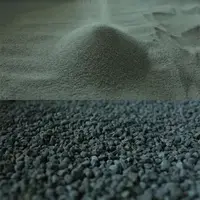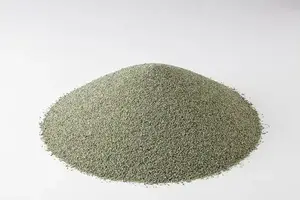
Natural mineral

Blasting Materials distributed by GritSablare are characterized by outstanding quality. This quality is reflected in an above-average service life, a very high productivity and value retention.
Olivine
- Highly refractory with very high melting point. Is the first mineral to crystallise from a mafic magma. Olivine’s physical characteristics make it appropriate for use in many high temperature applications.
- Uses: Eccentric bottom tapping (EBT) taphole filler • slag conditioning • refractory bricks / castables / tundish linings • blasting abrasive • foundry sand • fluidised bed combustion (FBC) • CO2 sequestration (combined with Mg) • fertiliser / soil amendment • water purification • mineral wool production.
Product available on order
- Blasting
1 - 3 mm • Sieve Analysis »
1 - 2 mm • Sieve Analysis »
- Eccentric bottom tapping (EBT)
3 - 8 mm
2 - 7 mm
1 - 5 mm
- Crude olivine
5 - 50 cm - Slag conditioner
10 - 40 mm
7 - 40mm - Foundry
AFS 45-50
AFS 65 - Casting
01 - 1 mm
0 - 05 mm
0 - 02 mm
- Big Bags of 1000 Kg
- Bags of 25 Kg (Moisture Proof Paper Bags)
- The material must be stored in a dry place.
Olivine Description

- Olivine is an ultrabasic mineral, with no free silica content. Grey/green odourless solid, insoluble in water. Olivine is a group name covering a family of solid solutions of iron and magnesium silicates of indefinite composition. It is a natural occurring mineral, consisting mainly of a solid solution of Forsterite (magnesium rich member) & Fayalite (iron rich member). The mineral is mined by an open cut method, crushed, milled, screened, cleaned via a complex suction system and stored in various product silos depending on its sizes;
- Olivine has a high melting point and is the first mineral to crystallise from a mafic magma. Forsterite crystallises first with Fayalite crystallising last when other minerals are just beginning to form. The early crystallisation of olivine is the reason that molten lavas can contain already crystallised grains of olivine. Olivine’s physical characteristics make it appropriate for use in many high temperature applications, such as EBT taphole sand and refractory bricks.
Olivine Types
Olivine Application

Scrap metal is melted in an electric arc furnace with Eccentric bottom tapping (EBT) at extremely high temperatures. Melted steel is tapped out through a nozzle in the bottom of the furnace. A very tough material is necessary to fill the nozzle to avoid slag problems. Only a superior product like Olivine is able to perform the dual service of (1) holding the molten metal at bay until it reaches its full temperature without metal penetration into the nozzle, and then (2) releasing cleanly and quickly to facilitate complete flow.
Olivine provided by GritSablare has unique chemical composition that enables it to maintain heat resistance up to 1780 °C - a temperature much higher than the temperature inside the furnace. Further, precise dimensions, shape and angular configuration of Olivine particles provide compaction properties which resist metal penetration.
When the molten metal reaches its optimum consistency, the nozzle is opened and Olivine pops through, allowing metal to flow. The nozzle does not freeze, making Olivine the perfect material to fill the nozzle in any EBT furnace.

- Olivine is suitable for applications in both blast furnaces and electric arc furnaces for the conditioning of furnace slag and provision of basicity control. It is added in any of 3 forms with the following benefits:
- Lump, added directly into the furnace. In this form olivine can replace some of the limestone and dolomite that is usually used as a flux in the reduction of iron ore. This is because olivine’s high MgO content, which has an average of 45-49% towards dolomite’s 20-22% with the consequence that a lower tonnage of material is required to achieve the predetermined MgO concentration in the furnace;
- Sinter. Olive can also be applied as a component directly to sinter stream. In this way inclusion of olive can reduce the sintering temperature by up to 100ºC which in turn leads to a tougher sinter, with fewer fines requiring recycling. The ultimate impact of these factors is that the overall capacity of the furnace is raised by as much as 15%.
- Pellets. Olivine can also be added directly to the iron ore as a flux during the formation of pellets with positive effects on the overall heat efficiency of the process.
Other uses of Olivine



Physical and Chemical Properties
| Physical Properties | |
|---|---|
| Appearance: | Solid |
| Color: | Grey/green |
| Shape particle: | Angular |
| Odor: | None |
| Density: | 3,2 g/cm3 |
| Hardness: | 6,5 – 7 Mohs scale |
| Melting point (°C): | Approx. 1780 °C |
| Initial sintering (°C): | Approx. 1450 °C |
| pH: | 7,5 – 8 |
| Solubility in water (g/L): | Immiscible |
| Chemical Composition | |
|---|---|
| MgO: | 45 - 48% |
| SiO2: | 40 - 44% |
| Fe2O3: | 7 - 9% |
| Al2O3: | 1 - 1,5% |
| CaO: | 0,65 - 1% |
| Lost on ignition: | max 1,5% |
| Ore composition | |
|---|---|
| Forsterite Mg2SiO4: | 96% |
| Fayalite Fe2SiO4: | 4% |
Testimonials
A beautiful collaboration, quality, promptitude and honesty carried us on a beautiful road...
Răzvan Harabagiu, Shareholder | Executive Manager, Alpaccess, Romania
A trustworthy brand, a professional team, a flawless service! We are happy to have them as our supplier for blasting agents and equipment.
Iulian Duna, Project Manager, Industrial Cruman, Ploiești - Romania
GritSablare, a reliable and fast partner, always involved to learn and find solutions that fits customers' needs.
Daniel Morari, COSMA Glass - water jet cutting
GritSablare, the largest blasting warehouse we are aware of... a flexible payment schedule for blasting equipment, moreover, a very good choice!
Ionel Zelca, Owner, Industrial Painting SRL - blasting and electrostatic painting




We provide first-class quality products, build long term relationships and develop strong connections with our clients









